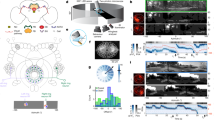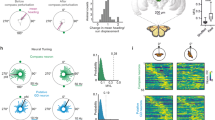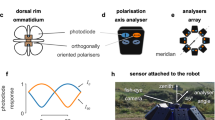Abstract
Animals which use a celestial compass to navigate in a particular direction are able to compensate for the movement of the Sun1–3. It has generally been assumed4–8 that this compensation is exact even though the rate of change of the position of the Sun's azimuth is not constant but varies according to the time of day, the date and the latitude. However, what can be deduced at best even from the most comprehensive studies of birds9, fishes10, spiders11,12 and bees13–16 is that the animals do not simply use the Sun's average rate of azimuth movement (15° h−1). The scatter in most data and methodological shortcomings (for example, see ref. 17) prevent a more specific conclusion. A further possibility, supported by recent experiments with bees18, is that animals do not use long-term information about the rate of movement of the Sun's azimuth at all but just extrapolate from the most recently observed rate of movement. Here, we show that ants do indeed compensate for the variable rate of movement of the Sun's azimuth even if they have not seen the sky for several hours. Small but consistent errors further suggest that the ants might acquire their knowledge of the Sun's azimuth movement by interpolation between successive memorized positions of the azimuth.
This is a preview of subscription content, access via your institution
Access options
Subscribe to this journal
Receive 51 print issues and online access
$199.00 per year
only $3.90 per issue
Buy this article
- Purchase on Springer Link
- Instant access to full article PDF
Prices may be subject to local taxes which are calculated during checkout
Similar content being viewed by others
References
v. Frisch, K. Experientia 6, 210–211 (1950).
Kramer, G. Naturwissenschaften 37, 377–378 (1950).
Kramer, G. & v. Saint-Paul, U. Naturwissenschaften 37, 526–527 (1950).
Chovnick, A. (ed.) Biological Clocks (The Biological Laboratory, Cold Spring Harbor, New York, 1960).
v. Frisch, K. The Dance Language and the Orientation of Bees (Harvard University Press, Massachusetts, 1967).
Keeton, W. T. Adv. Study Behav. 5, 47–132 (1974).
Schmidt-Koenig, K. Avian Orientation and Navigation (Academic, London, 1970).
Schoene, H. Orientierung im Raum (Wiss., Stuttgart, 1980).
Schmidt-Koenig, K. Biol. Bull. 124, 311–321 (1963).
Braemer, W. & Schwassmann, H. O. Erbebn. Biol. 26, 182–201 (1963).
Papi, F., Serretti, L. & Parrini, S. Z. vergl. Physiol. 39, 531–561 (1957).
Papi, F. & Syrjaemaeki, J. Archs ital. Biol. 101, 59–77 (1963).
Renner, M. Z. vergl. Physiol. 42, 449–483 (1959).
New, D. A. T. & New, J. K. J. exp. Biol. 39, 271–291 (1962).
Beier, W. & Lindauer, M. Apidologie 1, 5–28 (1970).
Edrich, W. Physiol. Ent. 6, 7–13 (1981).
Birukow, G., Fischer, K. & Boettcher, H. Ergebn. Biol. 26, 216–234 (1963).
Gould, J. L. Science 207, 545–547 (1980).
Santschi, F. Rev. Suisse Zool. 36, 25–70 (1929).
Wehner, R. Scient. Am. 235/1, 106–114 (1976).
Harkness, R. D. & Wehner, R. Endeavour, N.S. 1, 115–121 (1977).
Hoelldobler, B. in How Animals Communicate (ed. Sebeok, T. A.) 418–471 (Indiana University Press, Bloomington, 1977).
Wehner, R. in Animal Orientation and Navigation (eds Galler, S. R., Schmidt-Koenig, K., Jacobs, G. J. & Belleville, R. E.) 421–436 (NASA, Washington DC, 1972).
Duelli, P. & Wehner, R. J. comp. Physiol. 86, 37–53 (1973).
Wehner, R. Himmelsnavigation bei Insekten. Neurophysiologie und Verhalten (Orell Füssli, Zürich, in the press).
Papi, F. Experientia 11, 201–202 (1955).
Pardi, L. Z. Tierpsychol. 14, 261–275 (1957).
Lanfranconi, B. thesis, Univ. Zurich (in preparation).
Batschelet, E. Statistical Methods for the Analysis of Problems in Animal Orientation and Certain Biological Rhythms (American Institute of Biological Sciences, Washington DC, 1965).
Wehner, R. Mitt. dt. Ges. allg. angew. Ent. 3, 214–217 (1981).
Author information
Authors and Affiliations
Rights and permissions
About this article
Cite this article
Wehner, R., Lanfranconi, B. What do the ants know about the rotation of the sky?. Nature 293, 731–733 (1981). https://doi.org/10.1038/293731a0
Received:
Accepted:
Issue Date:
DOI: https://doi.org/10.1038/293731a0
This article is cited by
-
The role of learning-walk related multisensory experience in rewiring visual circuits in the desert ant brain
Journal of Comparative Physiology A (2023)
-
Navigation and orientation in Coleoptera: a review of strategies and mechanisms
Animal Cognition (2021)
-
Multimodal interactions in insect navigation
Animal Cognition (2020)
-
The Cataglyphis Mahrèsienne: 50 years of Cataglyphis research at Mahrès
Journal of Comparative Physiology A (2019)
-
Empirical corroboration of an earlier theoretical resolution to the UV paradox of insect polarized skylight orientation
Naturwissenschaften (2014)
Comments
By submitting a comment you agree to abide by our Terms and Community Guidelines. If you find something abusive or that does not comply with our terms or guidelines please flag it as inappropriate.



